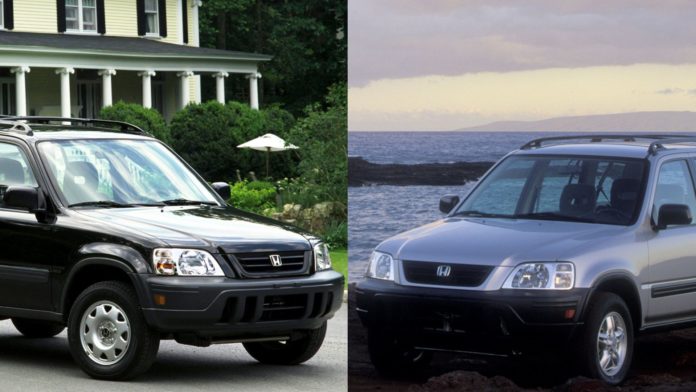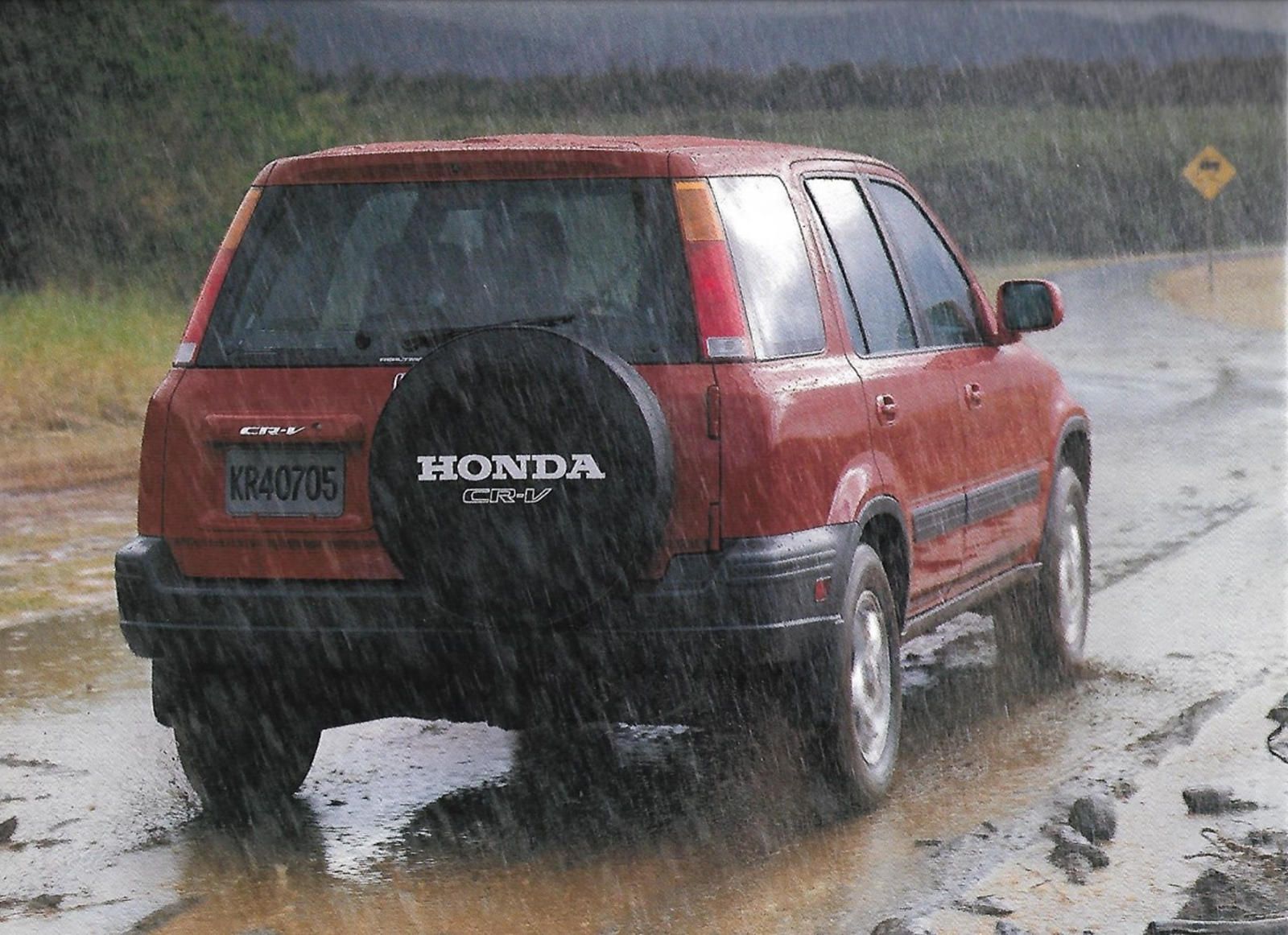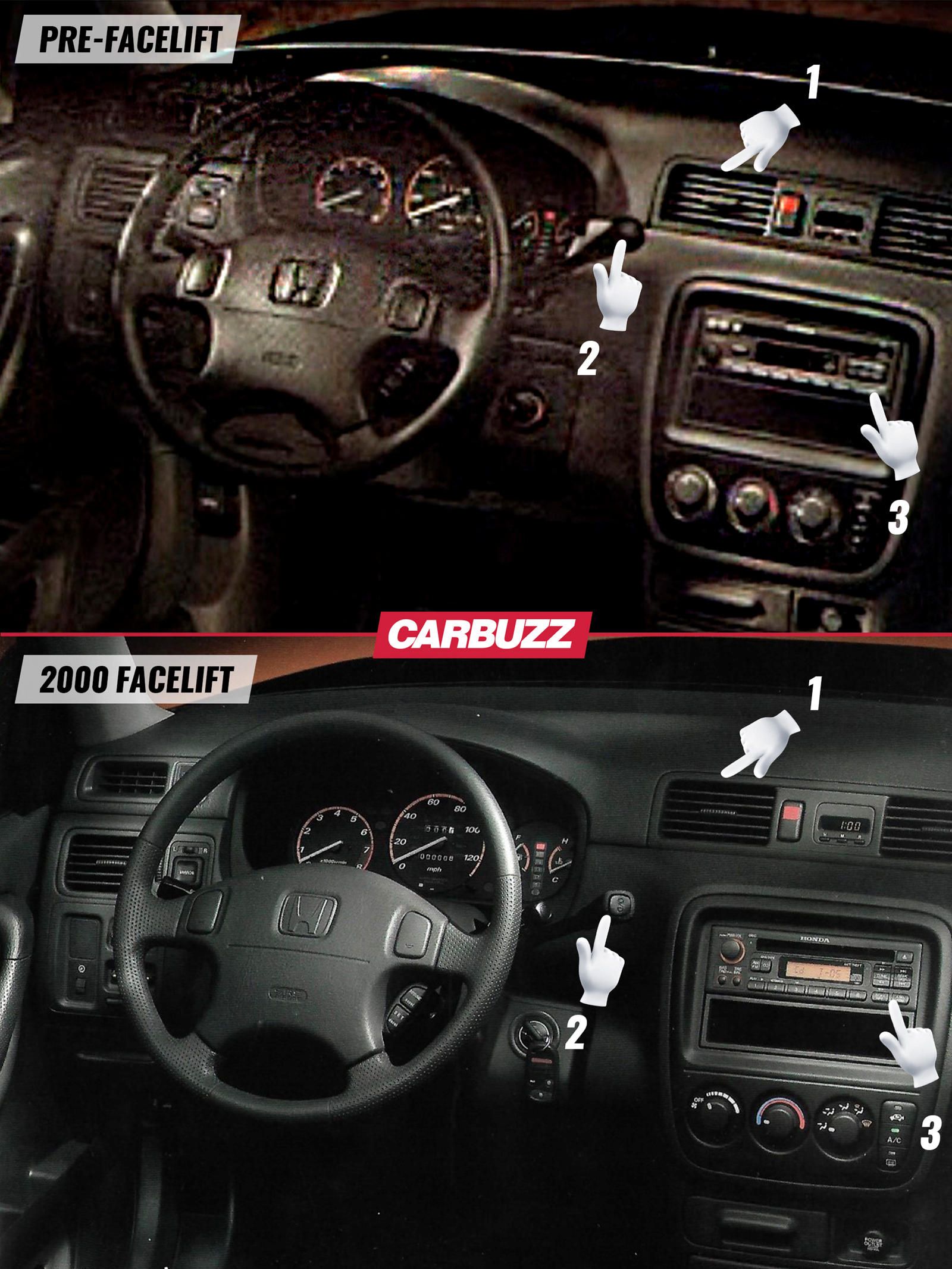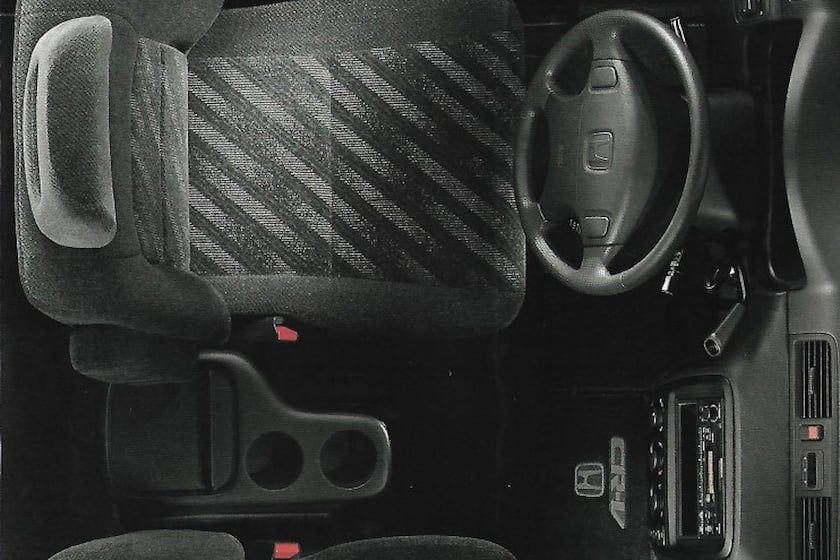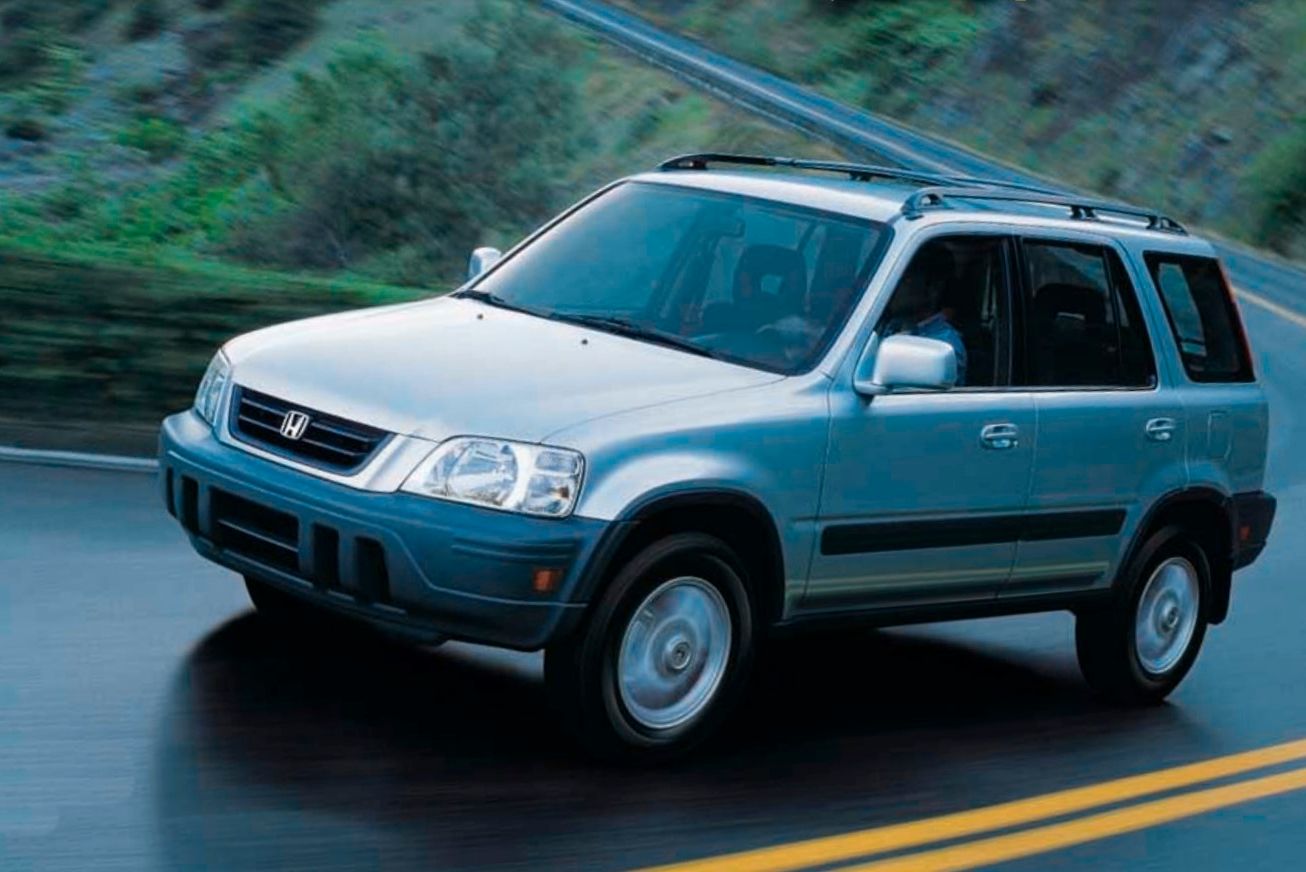First-Generation Honda CR-V What Owners Say
- The Honda CR-V is praised by its owners for its impressive interior quality. While it does feature fabric seats and many plastic trimmings, everything appears to be well put together and able to stand the test of time.
- The CR-V may ride fairly high off the ground, but users note that it is impressive around a series of bends thanks to its front and rear double wishbone suspension. You also enjoy a fairly comfortable ride.
- There are some issues noted with its B20 powertrain, but most owners assure that if it is routinely maintained, it is unlikely to cause any serious mechanical problems and is very reliable.
- While the B20 is characterful, there is a lack of torque with its 133 lb-ft output. This is particularly noticeable in the all-wheel drive four-speed automatic configuration. If you’re looking for a crossover that is expected to carry heavy loads, this may not be the choice for you.
- Cambelts and a lack of hydraulic lifters mean that the CR-V requires more engine maintenance than peers with timing chains and hydraulic valve lifters. The cost of maintenance is not outrageous, but there are additional elements that have to be monitored.
- The CR-V is marketed toward adventurous owners, which is why its weak front suspension is a hindrance to many owners that may frequent untarred surfaces.
1st-Gen CR-V Facelift
Internationally, the Honda CR-V RD3 was handed noteworthy visual changes for its 1999 facelift, but here in the USA one model year later, most of the interior and exterior remained untouched, particularly from the front and rear.
To give the updated CR-V a touch of new life, a new set of textures for the HVAC controls are joined by a slightly more recessed pair of air vents located beside the LED clock (1). You’ll also notice a new column-mounted gear selector (2) and audio system (3).
Engine, Transmission and Drivetrain
The 1st-gen CR-V was available with two variations of the same engine. The first two model years employed the B20B4, while the later years received the B20Z2 unit. These are both naturally aspirated 2.0-liter inline-four gasoline powertrains without V-TEC. The key difference between these powertrains is the compression, as the construction and dimensions are almost identical. Both powertrains were offered with a five-speed manual or four-speed torque-converter automatic transmission with the choice of front- and four-wheel drivetrains, namely the RD2 and RD1, respectively.
2.0L Inline-4 Gas DOHC B20B4/B20Z4
|
Horsepower |
Torque |
Transmission |
Drivetrain |
|---|---|---|---|
|
126/146 hp |
133 lb-ft |
Five-speed manual or five-speed automatic |
RWD/AWD |
The B20B4 is a low-compression engine that delivers 126 horsepower at 5,400 rpm and 133 lb-ft of torque at 4,300 rpm with a redline of 6,500 rpm. It uses an aluminum construction with 16-valves, dual overhead cams, and multi-point injection. The 1997 model was only available with a four-speed automatic and all-wheel drive, but a five-speed manual all-wheel drive and four-speed automatic front-wheel drive was introduced in 1998.
From 1999 onwards, Honda used the B20Z4, which featured a higher compression ratio, which allowed for a higher power output of 146 hp. The torque figure remains unchanged, but it is accessed later, at 4,500 rpm. Like the B20B4, this was available with front-wheel drive four-speed automatic and all-wheel drive five-speed manual/four-speed automatic drivetrains.
Thanks to its fairly basic design, Honda’s B20 mill is generally a dependable powertrain if you adhere to the routine maintenance schedule. What you do need to be aware of is the fact that it does not have hydraulic valve lifters, so the valve clearances will have to be adjusted every 20,000 miles. It also suffers from weak oil seals, as well as a marginal oil pump, thermostat, and head gasket. The timing belt isn’t problematic, but it is a part that needs to be routinely changed.
1997-2001 1st-Gen Honda CR-V MPG
Regardless of powertrain or configuration, the first-generation CR-V offers more or less the same EPA mpg estimates. All derivatives apart from the B20Z2 AWD five-speed manual have an estimated gas consumption of 19/23/21 mpg for the city/highway/combined cycles. The B20Z2 AWD five-speed manual is marginally heavier on a city cycle with its 20 mpg estimate. Looking at the real-world combined figures, it appears that owners of the CR-V have been able to beat the EPA’s estimates, with figures ranging from 21.2 to 23.9 mpg. Be mindful that these figures are sourced from drivers whose usage patterns are not monitored by the EPA and may include varying driving styles; they should thus not be treated as official figures.
|
EPA MPG (CITY/HIGHWAY/COMBINED) |
REAL-WORLD COMBINED MPG* |
|
|---|---|---|
|
B20B4 2.0-liter inline-four AWD four-speed automatic |
19/23/21 |
21.2-23.8 |
|
B20B4 2.0-liter inline-four FWD four-speed automatic |
19/23/21 |
23.2 |
|
B20B4 2.0-liter inline-four AWD five-speed manual |
19/23/21 |
23.3 |
|
B20Z2 2.0-liter inline-four FWD four-speed automatic |
19/23/21 |
22.6-23.9 |
|
B20Z2 2.0-liter inline-four AWD five-speed manual |
20/23/21 |
22.4-22.7(2001) |
|
B20Z2 2.0-liter inline-four AWD four-speed automatic |
19/23/21 |
22.7-23.9 |
* Real-world mpg and MPGe figures are provided by the EPA. Once a car has been on sale for a significant period of time, the EPA gets real-world figures directly from the customer base. These figures are then provided on the EPA website. Real-world figures are not available for certain models due to a lack of sales, or not enough people partaking in this after-sales survey.
Safety
The CR-V compact SUV delivers strong results from its NHTSA crash tests, apart from the rollover test. In the frontal impact, the driver’s side is awarded four stars while the passenger fares a bit better with its five-star rating. Five stars are awarded to both the driver and rear passenger sections in the side crash test, while three stars are given to both the front-wheel and all-wheel drive in the rollover crash test.
Standard safety features in the 1997 Honda CR-V include front airbags for the driver and passenger. ABS is an optional extra for the front-disc and rear-drum brake setup for all trims other than the flagship EX, on which it is standard. Second-row child-seat tether anchors are added to the 2001 model year.
US NHTSA Crash Test Result (2001)
|
Frontal Barrier Crash Rating (Driver) |
4/5 |
|
Frontal Barrier Crash Rating (Passenger) |
5/5 |
|
Side Crash Rating (Driver) |
5/5 |
|
Side Crash Rating (Passenger) |
5/5 |
|
Rollover Rating |
3/5 |
1st-Gen Honda CR-V Trims
There are only two trims available for the 1st-gen Honda CR-V RD1 and RD2, these being the base LX and flagship EX. For a car that came out in 1997, the list of standard features for both trims is reasonable for the segment it competes in, but not necessarily class-leading. They all feature the same powertrain, but the drivetrain configurations do vary. The LX was introduced at launch and was joined by the EX one year after launch as a more complete package.
For the 2000 model year, Honda introduced a special-edition trim, aptly named the SE, which featured a leather-lined interior, upgraded sound system, and privacy glass. This could only be had with the all-wheel drive automatic configuration.
1997-2001 LX
|
Engine |
Transmission |
Drivetrain |
|---|---|---|
|
2.0-liter inline four |
five-speed manual or four-speed automatic |
FWD/AWD |
The launch model year of the CR-V is only available with the LX trim. This features 15-inch alloy wheels, dual electrically adjustable door mirrors, a reclining driver’s seat with manual height adjustment, all-electric windows with an auto-down function for the driver’s window, power locking doors, cruise control, air-conditioning, an AM/FM stereo system with a CD player connected to four speakers, and a removable folding picnic table. Remote keyless entry and ABS were available as an optional package. In 1998, the LX was introduced with an FWD drivetrain that sported 15-inch steel wheels and a cassette and radio system. The LX can be had as a front- or all-wheel drive model with the five-speed manual transmission being available for the latter and the four-speed automatic for both.
1998-2001 EX
|
Engine |
Transmission |
Drivetrain |
|---|---|---|
|
2.0-liter inline four |
five-speed manual or four-speed automatic |
FWD/AWD |
The EX trim was introduced in 1998 as an offering aimed at consumers who desired a slightly more premium experience. The standard-features list was expanded over the LX with the inclusion of remote keyless entry, 15-inch alloy wheels, a CD player, and body-colored door handles and mirrors. The EX is available with the same drivetrain options as the LX.
2000-2001 SE
|
Engine |
Transmission |
Drivetrain |
|---|---|---|
|
2.0-liter inline four |
Four-speed automatic |
AWD |
The SE was available for the last two years of the first-gen CR-V’s lifespan as a special edition model with a leather-lined interior, CD and cassette player audio system, and privacy tinted windows, a hard cover for the spare wheel, body-colored side moldings, and a unique Naples Gold metallic paint available as standard. This model is only available with the all-wheel drive system and four-speed automatic transmission.
First-Gen Honda CR-V Features
|
LX |
EX |
SE |
|
|---|---|---|---|
|
Back-Up Camera |
N/A |
N/A |
N/A |
|
Bluetooth Connection |
N/A |
N/A |
N/A |
|
Leather Seats |
N/A |
N/A |
N/A |
|
Apple CarPlay |
N/A |
N/A |
N/A |
|
Keyless Entry |
O |
S |
S |
|
Keyless Start |
N/A |
N/A |
N/A |
|
HD Radio |
N/A |
N/A |
N/A |
|
Alloy Wheels |
O |
S |
S |
|
Sunroof |
N/A |
N/A |
N/A |
Interior, Trim And Practicality
By embracing the compact crossover body style and unibody chassis, Honda was able to create a car with small exterior proportions and generous interior space. In the front row, the driver and passenger are treated to 40.5 inches of headroom and 41.5 inches of legroom. This is more than enough for anyone standing taller than 6’4″. The rear is a bit more cramped with its headroom figure of 39.2 inches and legroom of 36.7 inches. The CR-V does not disappoint in the cargo department where it offers 29.6 cubic feet. This is more than enough room to fit four large suitcases for a family weekend away. When you fold the seat down, cargo space is expanded to 67.2 cubic feet. Both LX and EX trims have fabric interior upholstery. Soft-touch plastic trimmings are used throughout the interior together with a polyurethane steering wheel. Storage compartments throughout the cabin are generous as well, with sizable bins for the front and rear doors. There are cupholders with a center tray table between the driver and passenger seats. Automatic models have console cup holders as well.
|
TRIM |
LX |
EX |
SE |
|---|---|---|---|
|
Fabric |
S |
S |
N/A |
|
Leather |
N/A |
N/A |
S |
1997-2001 Honda CR-V 1st Generation Maintenance and Cost
The 1997-2001 first-gen CR-V requires an oil change every 7,500 miles but the oil filter only needs to be replaced every 15,000 miles. The air-cleaner element needs to be replaced every 30,000 miles together with the spark plugs and cabin filter. At this interval, it is also advised that you adjust the auxiliary drive belts. The first engine-coolant change needs to take place at 120,000 miles. Thereafter, this must be done every 60,000 miles. Honda says that both the manual and automatic transmissions need an oil change every 120,000 miles, but we strongly recommend that the self-shifter’s fluid is changed every 60,000 miles. AWD models will need a rear-differential fluid change every 90,000 miles. According to Honda, the engine’s timing belt must be replaced every 105,000 miles or seven years. Replace the water pump at the same time because it runs off the cambelt and doing everything at once saves on labor costs. Brake fluid needs to be changed every 36 months, irrespective of the mileage traveled. You can expect to spend close to $410 on annual routine maintenance for the 1st-gen Honda CR-V RD1 and RD2.
1st-Gen Honda CR-V Basic Service
Both the B20B4 and B20Z4 use the same oil type and have the same oil capacity, so an oil and filter change should not cost more than $53 for either. A new air filter is priced at around $18, while a set of four spark plugs should cost in the region of $20.
First-Gen Honda CR-V Tires
|
LX |
EX |
SE |
|
|---|---|---|---|
|
Tire Size |
P205/70SR15 |
P205/70SR15 |
P205/70SR15 |
|
Wheel Size |
15″ x 6.0″ |
15″ x 6.0″ |
15″ x 6.0″ |
|
Spare Tire |
P205/70SR15 |
P205/70SR15 |
P205/70SR15 |
Check Before You Buy
1997-2001 Honda CR-V recalls include one for a faulty airbag inflator that may rupture or underinflate in the event of a collision. CR-Vs assembled from 1997 to 1999 were subject to a recall for an ignition switch that could cause the engine to stall due to a bad electrical contact. 1998 and 1999 CR-V models were recalled for a bad wiring-harness routing that may result in windshield-wiper problems. No recalls were issued for the Honda CR-V’s transmission.
1997-2001 Honda CR-V Common Problems
Weak Front Suspension
The Honda CR-V has double-wishbone front suspension which gives it an engaging feel, but unfortunately, it is not very robust and is known to suffer several suspension problems. The front strut top mount, shock absorber, control arm, and wheel bearings are the most notorious areas of concern. Cars that are subjected to low loads and smooth surfaces are unlikely to struggle with these problems.
If the front strut top mount fails, you will notice a knocking noise on rough roads. If this part goes, it is highly likely that your bushings and wheel bearings will also be affected, which will result in knocking and popping noises while driving. The entire strut will need to be removed to replace these parts. Anti-roll-bar subframe mounting bushes and end-link ball joints are also prone to failure around this time. Once this occurs, you will notice unusual noises and movement from the anti-roll bar while cornering. A good way to test whether this part has failed is by wedging a pry bar between the roll bar and subframe. If it lifts too easily, it means the bush needs to be replaced. Clunking noises while driving will likely be due to the end-link ball joint being in need of replacement.
The front shock-absorber struts are another area of concern. You’ll know this part is starting to fail when you notice rattling noises when driving over rough surfaces. Oil leaks around the shock absorber are also a sign. The front will also be a bit bouncier, and there will be a lack of stability while cornering at speed. This can happen as soon as 50,000 miles.
A failed front control arm will also result in poor handling characteristics, including vague steering when changing lanes, as well as uneven tire wear. Expect this to occur after 80,000 miles. Worn wheel bearings emit a droning noise when you pass 30 mph. These tend to fail at the 70,000-mile mark.
Mileage: Failure of the Honda CR-V’s front strut top mount and anti-roll bar are dependent on the type of surface the car is driven on, but you can expect an average lifespan of 100,000 miles. Front shock absorbers appear to have a lifespan of 50,000 miles. Strut assemblies may cave in at 80,000 miles. Front control arms can start giving issues at 80,000 miles. Wheel bearings appear to last for 70,000 miles on average.
Cost: Repairing the CR-V’s front shocks and struts will cost in the region of $600, including parts and labor. A front stabilizer-bar link and bush replacement will cost $160. A new front control arm will set you back $800, and wheel bearings are likely to cost $400 to replace.
How to spot: All front-suspension problems will cause instability while driving, particularly while cornering, and loud rattling and knocking noises. Worn wheel bearings will give off a droning noise above 30 mph. This sound will get louder as speed increases and when going around curves.
Water Leaks In The Passenger Floorboard
The Honda CR-V’s interior is generally well put together, but the interior suffers from an annoying leak on the passenger floor well side. This is due to a worn cowl seal. This is an issue that often starts to occur after 130,000 miles and will require you to replace the seal. This issue will be more prevalent on cars that are parked in the rain more frequently. Usually, it is best to avoid this by ensuring that your CR-V is protected from the elements when parked. If you don’t have access to a garage or covered parking, the next best thing is to consider a weather-resistant car cover.
Mileage: The windshield cowl seal will start to show signs of wear at 130,000 miles.
Cost: Replacing this part should set you back about $120.
How to spot: Wet spots in the passenger floorwell indicate that the CR-V’s cowl seal has worn out.
Broken LED Clock
The LED clock located between the CR-V’s central dash air vents is subject to failure. The reason for this is a bad electrical circuit that will need to be soldered by an auto electrician. It is a common issue for the Japanese compact crossover, but thankfully it is a relatively quick and inexpensive repair.
Mileage: The LED clock’s electrical circuit can fail at any mileage and is more age-dependent.
Cost: Resoldering the electrical circuit of the LED clock should not exceed $20.
How to spot: If the clock fails to light up, it is likely that the electrical circuit has failed.
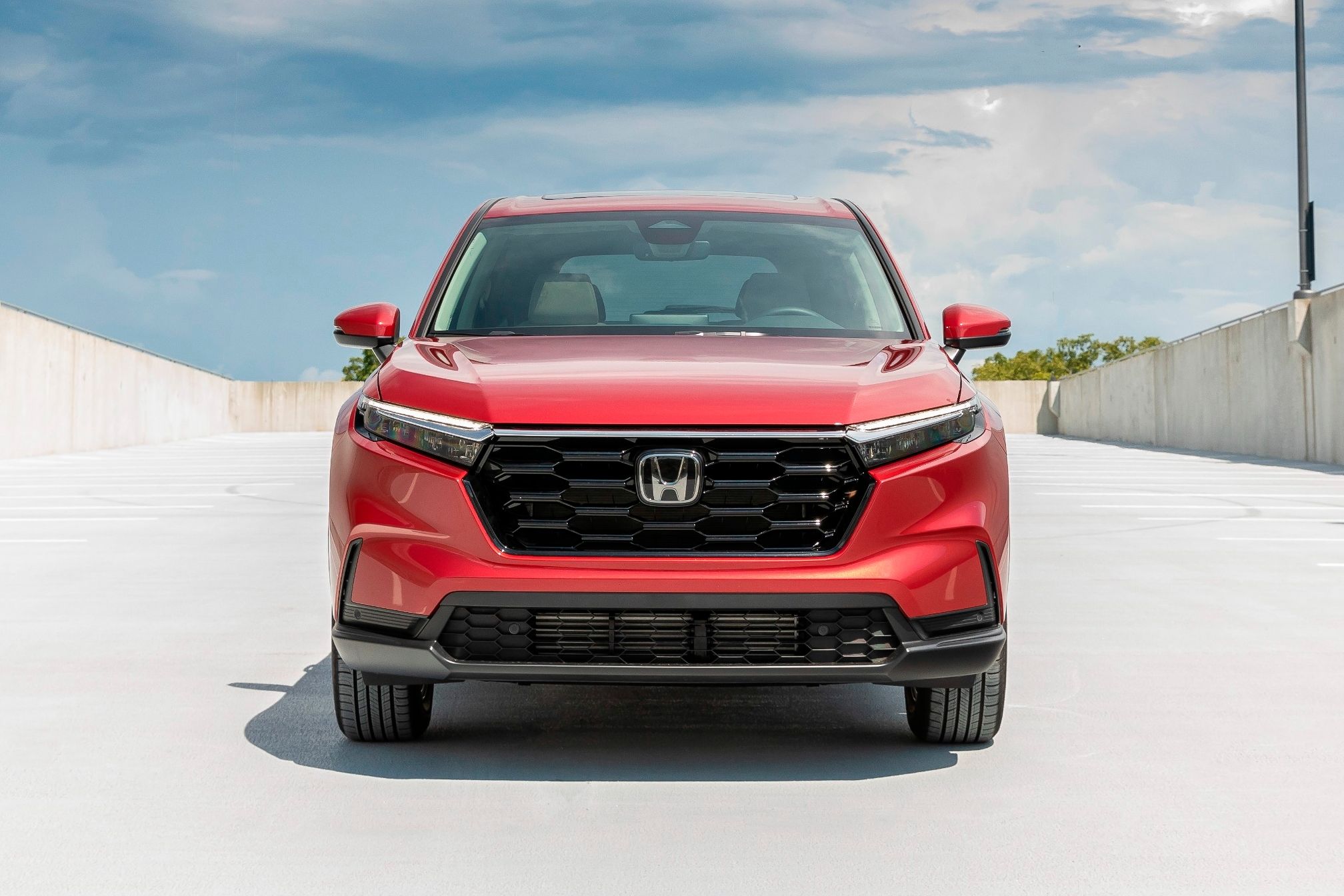
Related
Honda CR-V Generations: Everything You Need To Know In One Place
The Honda CR-V started small in the ’90s but is a class-leading compact crossover today with a hybrid-heavy powertrain lineup.
B20 2.0-liter Inline Four Common Problems
Honda’s B20 is generally a dependable engine if looked after and routinely maintained, but it is not perfect or problem-free. Engine-reliability problems that it appears to struggle with include a weak oil pump, thermostat, head gasket, and oil seals. The front crankshaft oil seal is notoriously weak and will start to show significant signs of wear as soon as 50,000 miles. You’ll know this when you start noticing engine spills around the engine bay and a rapid decline in the oil level. Thankfully, this is a relatively inexpensive repair, but it should be done as soon as it is noticed, so check the oil level frequently.
The oil pump and thermostat of the B20 may fail after 60,000 miles. If your oil pump has failed, you will notice a low-oil-pressure warning light, a rise in engine temperature, strange knocking noises due to a lack of lubrication if ignored, and eventually total engine failure. A failed thermostat will result in the engine overheating and should be replaced as soon as this occurs as this too can lead to engine failure.
A weak head gasket is the main cause for concern when it comes to the B20 as this can cause problems from 150,000 miles. It tends to fail suddenly. You’ll notice poor engine performance and a hesitation problem on acceleration, which will lead to the P1399 fault code, white smoke from the exhaust system, and oil and coolant leaks. If ignored, engine failure is guaranteed. If you ensure that your oil and coolant are always topped up, you may never encounter this issue, but it is still a problem you must keep an eye out for.
Two things that you need to consider with the B20 is that it does not have hydraulic valve lifters, so the valve clearances need to be adjusted every 20,000 miles to avoid camshaft wear and valve problems. Also, be mindful that it has a timing belt that must be replaced every 105,000 miles or seven years. If the water pump gives out, replace the cambelt at the same time because it includes much of the same labor. A seizing water pump can, therefore, also cause the belt to snap.
Mileage: The front crankshaft seal may start to show signs of wear at 50,000 miles. Oil-pump and thermostat failure can occur at 60,000 miles. Head gaskets start becoming an issue at 150,000 miles. Valve clearances need to be adjusted at 20,000-mile intervals, while the timing belt will need to be replaced every 105,000 miles or seven years.
Cost: Having a new front crankshaft seal fitted will cost about $105. A new oil pump can set you back up to $1,140, while the thermostat can result in a $385 repair bill. Replacing the head gasket is a costly procedure that may carry a bill of up to $2,250. A valve-clearance adjustment will add $221 to your service bill, while a timing-belt change is likely to cost at least $700.
How to spot: A worn front crankshaft seal will result in engine oil spills and a drop in the oil level. A bad oil pump will trigger the low-oil-pressure warning light, a rise in engine temperature, and eventually knocking noises due to a lack of lubrication, leading to engine failure. If the thermostat fails, you’ll have overheating problems. Failed head gaskets will cause poor performance, white smoke from the exhaust system, oil and coolant leaks, milky, coolant-contaminated oil, and oil-contaminated coolant.
Less Common Problems And Problem-Free Areas
Other less common issues you may encounter in your 1997-2001 1st-generation Honda CR-V include an AC/heater/fan problem where the system blows warm air due to a failed AC compressor, fast-wearing lock tumblers that will result in a master door-switch problem that will see the door locks getting stuck, hard shifts from first to second gear in automatic models, a weak master-cylinder reservoir filter that can break, and a whining noise from a worn alternator.
- The Honda CR-V is generally a mechanically robust vehicle, so it is unlikely that you’ll have problems with the AWD system, torque-converter automatic transmission’s shifting, the overdrive, clutch, or throttle-position sensor.
- On a manual Honda CR-V, clutch problems are rare.
- Honda CR-V’s electrical problems, such as starter or stalling problems, starting in damp weather, or problems with the battery, distributor, ground, power windows, cruise control, or speedometer should not be too common.
Which One To Avoid
The pre-facelift RD1 Honda CR-V models should be avoided because these were subject to the most recalls and predominantly feature the B20B4 engine that has been criticized for being underpowered. The CR-V may have traversed rough terrain and while that is the market it was aimed at, the weak front suspension means that its longevity is impaired, so it is best to avoid models used frequently for recreational use off the beaten path. The drivetrain configuration is dependent on your needs, but considering that automatic transmissions tend to be more expensive to run and maintain than manuals, we would recommend opting for an example with a third pedal. This means that you will have to forgo the front-wheel drive trims as those are only available with the four-speed auto. The LX trim is not far away from the EX in terms of standard features but in this case, more is always better, so we’d say it is best to avoid the base model. Steer clear of cars not fitted with the optional ABS package, as this is regarded as a required safety feature nowadays.
Which One To Buy
The best first-generation Honda CR-V purchase is a 2000 or 2001 EX AWD five-speed manual that has not been worn out on rough roads. These models were subject to only one recall and have the more powerful B20Z2 engine, which adds to its value for money. The EX trim features compelling standard features, such as remote keyless entry, alloy wheels, and a CD player. For the sake of maintaining the CR-V culture, ensure that the branded picnic table is still in the trunk as Honda no longer sells this part.
1st-Gen Honda CR-V (RD1-RD3) Verdict
There is no doubt that the CR-V is one of the pioneers of the compact SUV and crossover segment and while it may not have had the grunt to match the likes of the Jeep Cherokee, it offers a simple high-riding proposition. The B20 powertrain is prone to a few wear-and-tear issues, but if -maintained and not abused, it is unlikely to be a problematic powertrain. The cabin experience is not outstanding but it offers all the basic necessities that you’ll need from a crossover produced during this era. Bear in mind that this is a unibody crossover, so even though Honda describes its all-wheel-drive system as four-wheel drive, it will not be able to traverse tough off-roading terrain like some of its more robust peers. First-gen CR-Vs have generally covered high miles, so hunting for a low-mileage model in near-showroom condition will require a keen eye and patience.

